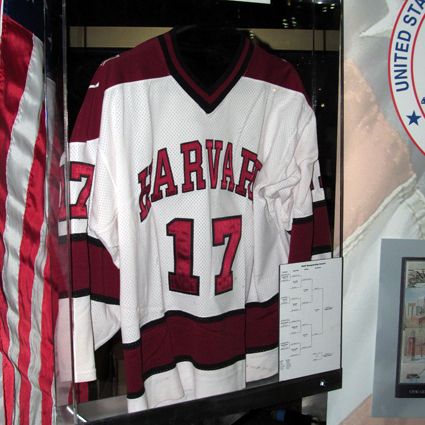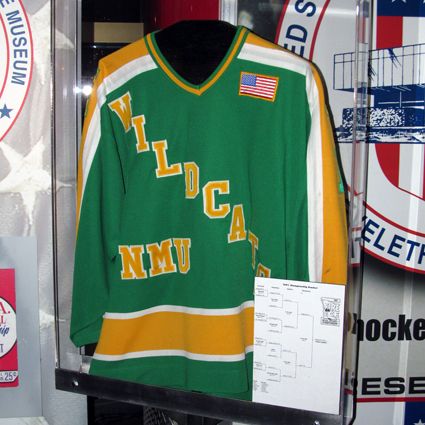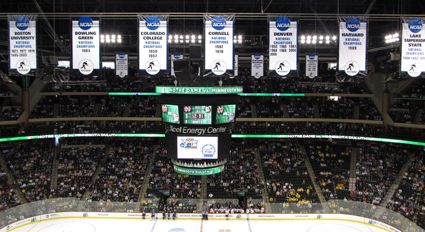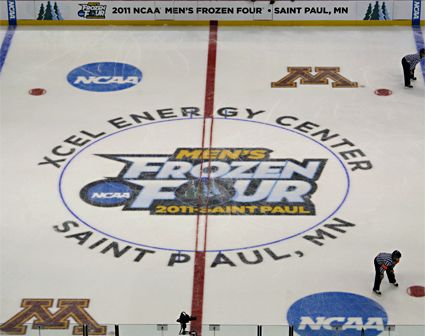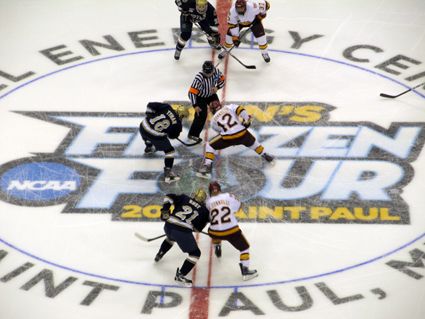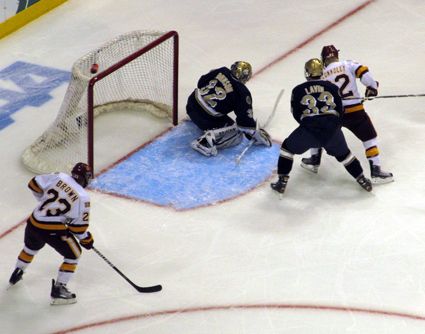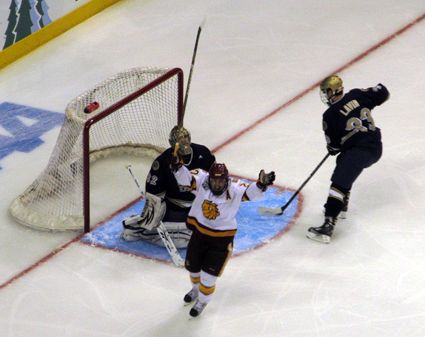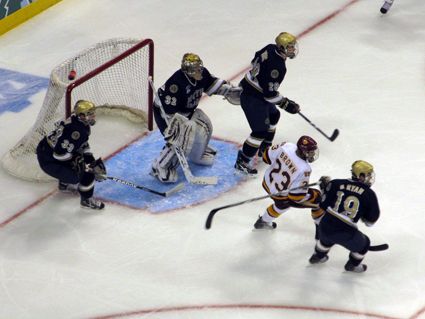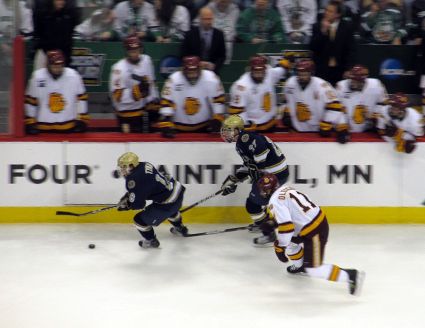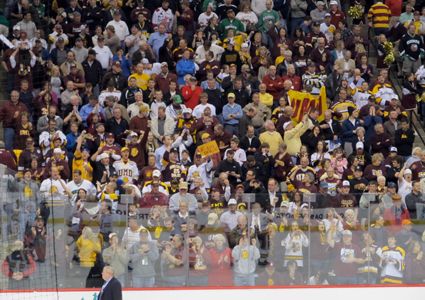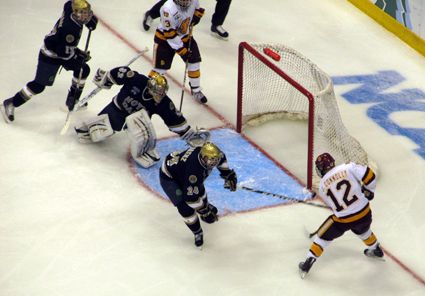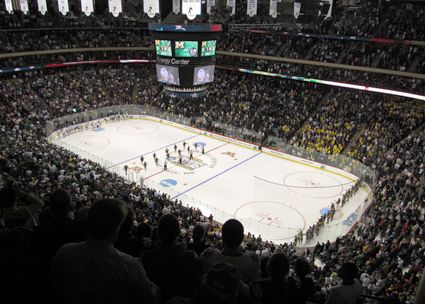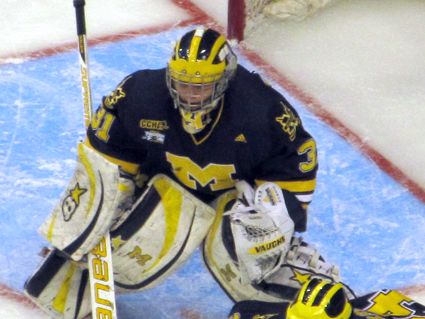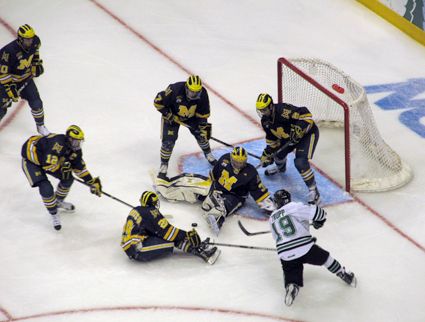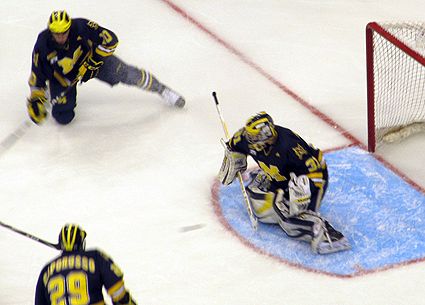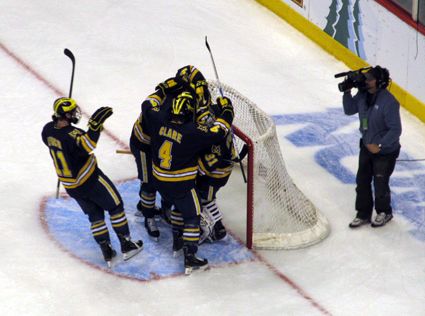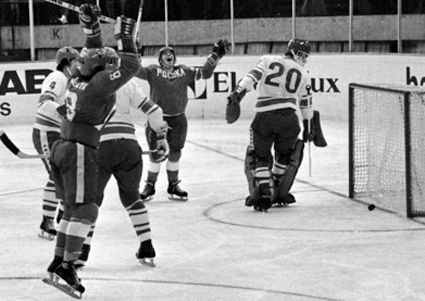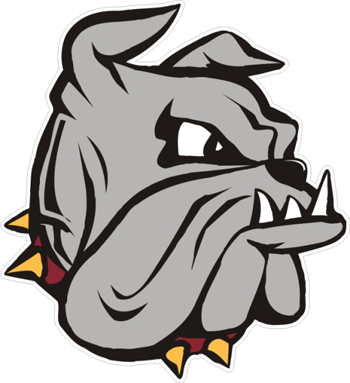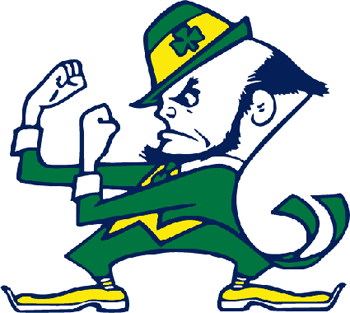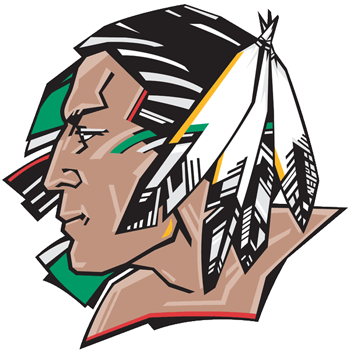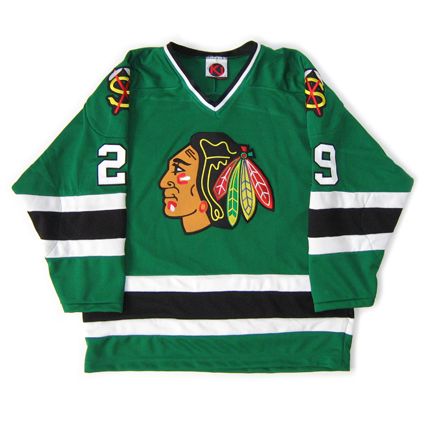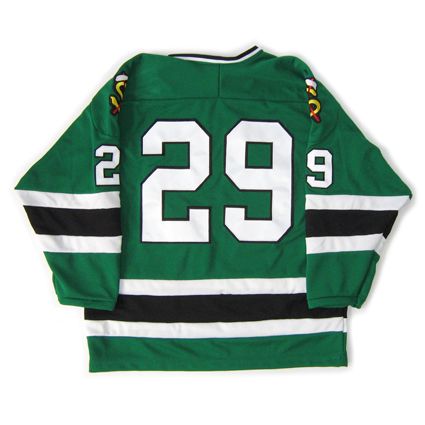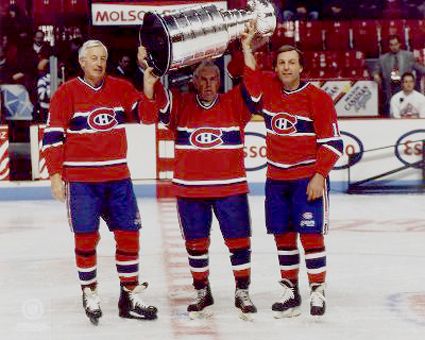Saturday, April 9, 2011
2001-02 University of Minnesota Golden Gophers Jordan Leopold jersey
Tonight the University of Michigan Wolverines take on the University of Minnesota-Duluth Bulldogs in the 2011 NCAA championship final in an attempt to extend their record number of NCAA championships to ten. On the other side, Duluth is seeking it's first ever championship, having only reached the finals once before, a memorable four overtime loss in 1984, which still ranks as the longest championship final in N CAA history.
The championship was inaugurated in 1948, which went to Michigan over Dartmouth 8-4 in Colorado Springs, Colorado where it was held for the first ten years before it began to be held in a new location each year.
The first location other than Colorado Springs to host the tournament, and the first time the NCAA championship was held in Minnesota was at historic Williams (later Mariucci) Arena on the University of Minnesota campus in Minneapolis in 1958. Denver won the first of their seven championships, which is tied for second to Michigan's nine.
In 1966 the championship returned to Williams Arena where Michigan State won their first championship 6-1 over Clarkson. It was the third consecutive year when the championship was won by a team from Michigan, following Michigan and Michigan Tech.
Two years later the championship returned to Minnesota as Denver won again in 1968 when they shut out North Dakota 4-0 in Duluth, the first time it hosted the finals.
It would be 13 years before Minnesota would host the championship when it was once again in Duluth. Wisconsin defeated their rivals Minnesota 6-3 at the Duluth Entertainment and Convention Center, the Bulldogs longtime home more commonly known as "The DECC" (pronounced "The Deck").
This brings us to 1989 when this weekend's host St. Paul, Minnesota first entered the picture when Harvard sent the home fans away disappointed when they defeated Minnesota 4-3 in overtime, often called one of the best games ever played. The game was held at the St. Paul Civic Center, which was opened in 1973 as home to the Minnesota Fighting Saints of the World Hockey Association.
On the occasion of the 2011 Frozen Four being held in St. Paul, the United States Hockey Hall of Fame has a display at this years tournament, which features jerseys from the various clubs who have won the championship in St. Paul. Sharp-eyed readers will recognize that each jersey is not from the specific season of the teams which won the championship, as the styles do vary in some cases from what was worn during each club's championship season.
Just two years later the Civic Center again played host to one of the all time classic finals in 1991. Northern Michigan and Boston University staged an epic final. Northern Michigan came back from being behind 3-0 to led big in the third period only to have BU, whose top line consisted of future NHLer's Shawn McEachern, Tony Amonte and Keith Tkachuk, come storming back with goal after goal after goal in the final eight minutes, including one with just 39 seconds remaining in regulation to tie the game at 7. Both teams failed to score as overtime stretched on, including multiple shots off the pipes for both teams, when finally Darryl Plandowski scored in the third overtime to end the emotionally exhausting game and win the championship for Northern Michigan. BU coach Jack Parker summed it up afterwards. "That wasn't a hockey game out there tonight. That was something different."
As thrilling as the 1991 final was, the championships return to St. Paul was the opposite, as Lake Superior State University destroyed Boston University 9-1 in the last game hosted by the Civic Center, which was demolished to make way for the Xcel Energy Center, which was built as part of the effort to return NHL hockey to Minnesota in 2000 in the form of the Minnesota Wild.
The 2002 final in St. Paul was a wild affair indeed, as the hometown University of Minnesota returned to the top of the heap for the first time since 1979 in front of 19,000 rabid fans when they scored a last minute goal with an empty net to force overtime. Grant Potulny, the only player on the team from outside of Minnesota, caused an eruption of biblical proportions with his championship winning goal in overtime to give Minnesota the victory.
This year is the second time the Xcel Energy Center has hosted the final and the eight time it has been decided in Minnesota.
Today's featured jersey is a 2001-02 University of Minnesota Golden Gophers Jordan Leopold jersey as worn during the 2002 Frozen Four held in St. Paul, Minnesota. Leopold was also the recipient of that season's Hobey Baker Award, given annually to the top college player in the United States.
This jersey also features the WCHA conference logo on the lower back hem and the 2002 Frozen Four tournament patch on the upper right chest.
The University of Minnesota is also the host school of this years Frozen Four.
Labels:
2011 Frozen Four,
Leopold,
University of Minnesota
Friday, April 8, 2011
2011 Frozen Four Semifinals
We attended the semifinals of the 2011 Frozen Four in St. Paul, Minnesota yesterday and wanted to share some of the action and color of the event.
The first game had the University of Minnesota-Duluth if the WCHA going up against Notre Dame from the CCHA.
The Xcel Energy Center was converted from it's usual NHL set up, most evidenced by the removal of the NHL logo banners, which were replaced by banners commemorating the NCAA champions over time.
Additionally, the Wild logo at center ice was replaced by the Frozen Four tournament logo.
The game looked to be a track meet in the first period as the teams were able to score at will. Notre Dame took an early lead and Duluth was able to respond. The Fighting Irish went back into the lead but Duluth scored the next two goals and the first period ended 3-2 in favor of the Bulldogs.
Duluth extended their lead with a goal in the second period and Notre Dame made it tense with a shorthanded goal two minutes into the third period, only the Bulldogs held on to advance to the championship game on Saturday.
Duluth was actually outshot by a wide margin, 34-21, but Kenny Reiter in goal for Duluth kept the Irish off the board as they pumped 15 shots on goal in the third period as they fought to tie the game. Duluth's power play proved to be the difference, converting of 3 of 6 chances, one of which was a text book cross-ice pass Mike Connolly converted into a gaping Fighting Irish net.
The evening game featured the University of North Dakota Fighting Sioux, also of the WCHA, against the University of Michigan Wolverines of the CCHA.
Quite simply, the story of this game was Michigan goaltender Shawn Hunwick.
Michigan scored first when a shot went off the post and bounced straight back into the slot. The fortunate Ben Winnett tried to control the puck, but it went off his stick toward the North Dakota goal, where it hit a defenseman and bounced right back to him. Given a second chance, he made the most of it, skating to his right around the cluster of bodies in front of the net and fired the puck past Fighting Sioux goaltender Aaron Dell, who was caught sitting in the crease, unable to respond.
No one in the 19,139 in attendance would have ever believed that would have been the end of the scoring in a game with the high powered Fighting Sioux, but Hunwick turned away wave after wave of Fighting Sioux shots.
Many of the Sioux shots went wide, Matt Frattin's wide open shot midway through the first period from the slot following a turnover in particular.
Later, Jason Gregoire of the Sioux tried to tie the game on his own with an electrifying rush, Hunwick jammed his foot against the post as Gregoire tried to slam the puck into the far side of the goal, stoning the best North Dakota chance of the game.
On another occasion, he deftly poke checked the puck as Brad Malone tried a similar move.
The Wolverines were badly outshot for the game 40-20, but spoiled the evening for the many Fighting Sioux fans in attendance, who were anticipating an all western final. Michigan sealed the victory with an empty net goal in the last minute for the final 2-0 score.
Check back on Monday for an amazing Frozen Four jersey gallery you won't want to miss. It's really going to be something special.
Labels:
2011 Frozen Four
1997-98 Poland National Team Mariusz Cerkawski Jersey
On this date in 1976, the greatest upset in World Championship history occurred when Poland defeated the Soviet Union 6-4.
Just two months earlier, the Soviet Union had won it's fourth straight Olympic gold medal, which included a 16-1 defeat of Poland. And when it came to the World Championships, the Soviets had won 12 out of the last 13 championships.
The Soviet roster contained some of the most recognizable stars in international hockey history, beginning with Vladislav Tretiak in goal, defenseman Valeri Vasiliev and forwards Valeri Kharlamov, Boris Mikhailov and Alexander Maltsev among others.
Combined, this team had only lost one game since 1972, while outscoring their opposition 294-63 in the previous four major tournaments. In the last seven games in which the two countries had met, the Soviets had won by scores of 9-3, 20-0, 8-3, 17-0, 13-2, 15-1 and 16-1.
About the only things Poland had in it's favor going into the game was that the tournament was being held in Poland and it was the opening game of the tournament, perhaps allowing Poland an shot at the Soviets before they had a chance to hit their stride.
The best Poland could simply hope for was to keep the score as low as possible. A win was simply out of the question.
Believing his team would have little trouble scoring, Soviet head coach Boris Kulagin opted to leave Tretiak on the bench and started Alexander Sidelnikov in goal. The Poles thrilled the 10,000 home fans in attendance when they not only scored at 10:21 of the first period on a goal by Mieczyslaw Jaskierski, but a goal that gave them a lead. Four minutes later, lighting struck twice when Ryszard Nowinski scored again to increase the lead to two goals at the end of the first period.
Surely the Soviets were threatened with Siberian exile between periods, and began to correct the aberration that was the first period when Mikhailov scored just 31 seconds into the second period.
Rather than giving in to the inevitable, the Poles amazingly responded when Wieslaw Jobczyk made it 3-1 at 2:44, once more igniting the home fans, but before they had a chance to settle back into their seats, Jaskierski sent the arena into pure bedlam when, just 16 seconds later, he netted his second goal of the game to push the lead to three.
Kulagin had seen the error of his ways, and pulled Sidelnikov a minute later, inserting Tretiak into the game. Buoyed by the arrival of Tretiak, the Soviets got one back at 5:14 when Alexander Yakushev scored to make the score 4-2, but the now confident home team responded quickly yet again when Jobczyk's second goal of the game found the back of the net at 6:40 to restore the three goal lead. The remainder of the period was scoreless, leaving the Soviets 20 minutes to score three to tie and four to win, and based on their most recent 16-1 win just two months prior, four goals in a period was well within the Soviet reach.
During the final period, the Polish fans sang and cheered continuously, and for the first 13 minutes, their team kept the Soviets off the scoreboard until Kharlamov made it 5-3 with seven minutes remaining, but Polish goaltender Andrzej Tkacz held the Soviets at bay as the fans continued to cheer throughout.
Jobczyk completed his hat trick with 20 seconds remaining with "the Katowice arena a complete madhouse" before Kharlamov scored a meaningless goal with five seconds remaining to make the final score 6-4 before the emotional scene of the Poles and their fans filling the building with the Polish national anthem.
Wieslaw Jobczyk completes his hat trick against the Soviet Union
The Poles returned to Earth the next day with a 12-0 loss to Czechoslovakia and were eventually relegated to the B Pool at the end of the tournament, making their shocking defeat of the Soviets just that much more remarkable.
Poland played it's first international game back in 1926 and played in its first Olympics in 1928 and competed in 13 of the next 15 Olympics up through 1992, but has failed to qualify since then.
Polish goaltender Andrzej Tkacz tries to fend off Valeri Kharlamov in the 1972 Winter Olympics
Their first World Championship participation came in 1930 and a good run of form saw them finish with a series of fifth place finishes in the first half of the 1970's, but since 1977 they have generally competed in Pool B, now called Division 1, having earned five promotions to the Top Division, but never managing to stay up following their promotion. Conversely, they have never been relegated to Division 2, one of only eight countries that can make that claim.
After their best period of competitiveness from the 1950's to the 1970's, they have been passed over by several countries, especially with the breakup of the Soviet Union resulting in a number of newer, competitive countries claiming places in the Top Division that would have been within Poland's reach before.
In recent times, Poland has seen a two born and raised native sons compete in the NHL, beginning with Mariusz Czerkawski, who played in 12 NHL seasons with Boston, Edmonton, the Islanders, Canadiens and Maple Leafs beginning in 1993. Czerkawski played in 745 games, scoring 435 points.
Joining him three years later was the rugged Krzysztof Oliwa, who skated in 410 games for New Jersey, which included winning a Stanley Cup in 2000, Columbus, Pittsburgh, the Rangers, Bruins and Flames, scoring 45 points and accumulating 1,447 penalty minutes over the course of nine seasons.
There have been other Polish-born players in the NHL, such as goaltender Peter Sidorkiewicz and Wojtek Wolski, but they emigrated to Canada as youth and did not play in Poland prior to making it in the NHL.
Today's featured jersey is a Nike 1998 Poland National Team Mariusz Cerkawski jersey as worn in the 1998 World Championships Pool B.
Czerkawski was drafted by the Boston Bruins in 1991 after playing in Poland. From there he played three seasons in Sweden before making a late season debut with the Bruins. A right wing, Czerkawski was probably best remembered for his time as a New York Islander, where he played for five seasons, which included two 30 goal seasons and setting career highs with 35 points and 35 assists for 70 points in 1999-00.
Today's first featured video is a highlight collection of Mariusz Czerkawski.
Next, a compliation of Krzysztof Oliwa fights with perhaps even a goal thrown in for variety.
Labels:
Czerkawski,
Poland
Thursday, April 7, 2011
1986-87 University of North Dakota Ed Belfour Jersey
Today is the first day of the 2011 NCAA Frozen Four which will take place in St. Paul, Minnesota at the Xcel Engery Center, normally the home of the NHL's Minnesota Wild.
The first game today will take place at 4 PM Central on ESPN2 when the University of Minnesota-Duluth Bulldogs of the Western Collegiate Hockey Association (WCHA) takes on The University of Notre Dame Fighting Irish out of the Central Collegiate Hockey Association (CCHA). The Bulldogs advanced to the Frozen Four by shutting out Union 2-0 and then #1 ranked Yale 5-3 while the Fighting Irish advanced by defeating Merrimack 4-3 in overtime and New Hampshire 2-1.
Duluth enters the Frozen Four with a record of 24-10-6. They finished 4th in the WCHA with 35 points, just 2 back of Denver in 2nd place. They are led by Jack Connolly's 58 points, followed by Justin Fontaine at 22 goals and 55 points and Mike Connolly, who totaled 53 points and led the team with 27 goals. Junior Kenny Reiter got both the wins in the East Regional and led the team with a 14-7-5 record.
UMD's program dates back to 1930 and they joined the WCHA in 1965 and have won the conference championship 11 times, including six in a row from 1956 to 1961 with the most recent in 1993. They have won the conference tournament three times.
They have never won the national championship, but have made it to the Frozen Four four times, 1984, 1985, 2004 and now 2011. Their appearance in 1984 ended with a historic 4 overtime loss to Bowling Green, while 1985 was another heartbreaker, a 3 overtime loss in the Semifinals.
Four Bulldogs players have won the Hobey Baker Award, Tom Kurvers (1984), Bill Watson (1985), Chris Marinucci (1994) and Junior Lessard (2004). In addition to the four Hobey Baker winners, the best known UMD alumni is NHL star Brett Hull.
Notre Dame enters the Frozen Four with a record of 25-13-5. They finished 2nd in the CCHA with 59 points, just 2 back of Michigan in first. They are led by freshmen T. J. Tynan's 53 points, followed by Anders Lee with a team leading 22 goals and 44 points. Sophomore Mike Johnson is the number one goaltender and posted a 20-9-4 record.
Notre Dame moved to Division I hockey in 1968 and they joined the WCHA in 1971. Ten years later they joined the CCHA, where they played for 2 years. After a year at the club level, they returned to Division I as an independent before rejoining the CCHA in 1992. They have won the conference championship twice in 2007 and 2009, as well as the conference tournament in both of those years.
They have never won the national championship, but have made it to the Frozen Four twice, in 2008 and again this year.
Today's second game pits the University of Michigan Wolverines of the CCHA against the University of North Dakota Fighting Sioux from the WCHA at 7:30 PM, also on ESPN2. The Wolverines advanced to the Frozen Four by outlasting Nebraska-Omaha 3-2 in overtime before getting past Colorado College 2-1 while the Fighting Sioux stormed their regional by destroying Rensselaer Polytechnic Institute 6-0 prior to thumping WCHA rival Denver, who they required double overtime to beat in St. Paul in the WCHA tournament eight days earlier, by a resounding 6-1.
Michigan enters the Frozen Four with a record of 28-10-4. They finished 1st in the CCHA with 61 points. They are led by Carl Hagelin's 18 goals and 48 points, followed by Louie Caporusso at 30 points. Senior Shawn Hunwick led the team in goal with a 21-8-4 record.
Michigan's program dates back to 1922 and they joined the CCHA in 1981 and have won the conference championships 21 times and 9 conference tournaments.
They have won the national championship 9 times, most recently in 1996 and 1998.
Two Wolverines players have won the Hobey Baker Award, Brendan Morrison (1997) and Kevin Porter (2008). In addition to the two Hobey Baker winners, the best known Michigan alumni are Mike Cammalleri, Mike Comrie, Mike Knuble, John Madden, Aaron Ward and goaltender Marty Turco.
North Dakota enters the Frozen Four with a record of 32-8-3 record and look like the favorites going in. They finished 1st in the WCHA with 43 points. They are led by Hobey Baker finalist Matt Frattin's 36 goals and 60 points, followed by Corban Knight at 44 points and Jason Gregoire, who totaled 43 points, one of five Fighting Sioux with 40 or more. Sophomore Aaron Dell led the team in goal with a stellar 30-6-2 record.
UND's program dates back to 1929 and they joined the WCHA's forerunner in 1951 and have won the conference championship 15 times and the conference tournament nine times.
They have won the national championship 7 times, most recently in 2000. Like nearby Duluth, North Dakota is expected to have plenty of support on hand in St. Paul.
Two Fighting Sioux players have won the Hobey Baker Award, Tony Hrkac (1987) and Ryan Duncan (2007). Frattin is expected to be named this year's winner of the award tomorrow night at 6 PM in St. Paul. Cam Atkinson of Boston College and Andy Miele of Miami University of Ohio are the other two finalists.
In addition to the four Hobey Baker winners, the best known UND alumni are Ed Belfour, Jason Blake, Dave Christian, T. J. Oshie, Zach Parise, Drew Stafford and Jonathan Toews.
The winners of today's games will meet on Saturday evening at 6:00 PM on ESPN.
St. Paul first hosted the Frozen Four in 1989 and again in 1991 and 1994 in the old St. Paul Civic Center. The Xcel Energy Center, built on the site of the Civic Center, has hosted one previous Frozen Four in 2002.
Today's featured jersey is a 1986-87 University of North Dakota Ed Belfour jersey. North Dakota captured the national championship in 1987, Belfour's only season with UND before turning professional despite not being drafted.
He would take the NHL by storm, winning the Jennings, Calder and Vezina trophies during his rookie season of 1990-91. He would play in five NHL All-Star Games, earn three more Jennings Trophies, another Vezina and a Stanley Cup with Dallas in 1999.
Fighting Sioux jerseys of this era are enormously popular for their take on the iconic Chicago Blackhawks jerseys, with only the red changed to green and the "C" in the secondary logo switched to an "S".
Here is a music video tribute to the 1987 North Dakota Fighting Sioux, featuring perhaps the worst performance of the most annoying song ever written, but the rare footage of the team in action is worth the audio punishment. No points will be deducted for watching with the sound off.
Wednesday, April 6, 2011
The 2011 Third String Goalie Jersey Bracket - The Finals
Today is the final day of the 2011 Third String Goalie Jersey Bracket to determine which one NHL jersey we feel stands alone above all others.
To follow along with the tournament as it develops, please visit our bracket online.
Matchup #3 brings #4 the Detroit Red Wings Home jersey up against #13 the Chicago Blackhawks Home jersey. The Blackhawks prevail in this one with a wider margin that you might anticipate. The greater contrast gained with the use of black on Chicago's jersey makes it more visually appealing than the lower contrast Red Wings jersey.
As a reminder, some very basic rules we used were to use an online bracket creator to randomly seed all 86 NHL jerseys used this season as documented by NHLUniforms.com, leaving out any one time only jerseys such as those worn in the Winter or Heritage Classic, giving the top 16 seeds in random order to the Original 6. Beyond that, we let the chips fall where they may. Now, on to the competition!
Matchup #1 of the Sweet 16 is #1 the Chicago Blackhawks Alternate against #16 the Toronto Maple Leafs Home jersey. The Blackhawks win due to their three colors, black, red and off white, which elevates them above the Maple Leafs two color jersey. Chicago's central stripe around the body adds even more visual interest, tipping the scales to the Blackhawks.
Matchup #2 gives us #8 the Chicago Blackhawks Road jersey taking on #9 the Toronto Maple Leafs Alternate jersey in another Chicago vs. Toronto meeting. Tough to call, but we're going to give this one to the Maple Leafs in overtime. Toronto's excellent use of this jersey for special occasions on the ice, such as the annual Hockey Hall of Fame Game, shows the rest of the league how a third jersey should be used. Add in the blue shoulders and the Leafs eek out a close one over a true classic.
Matchup #4 sees #28 the Los Angeles Kings Vintage jersey taking on #12 the New York Rangers Home jersey. Similar to the previous battle, the Rangers red, white and blue jumps out at you more than the Kings darker purple and elemental gold stripes. There's a reason the Rangers jersey has been around so long, and a reason the Kings moved on from their original jerseys. Rangers advance.
Matchup #5 pairs #66 the Edmonton Oilers Home jersey and #82 the Minnesota Wild Home sweaters. It's time to face the facts. If the Oilers had not won five Stanley Cups in this jersey, it would not be as revered. Bluntly, blue and orange trimmed in white is a rather garish color scheme and Minnesota prevails in this battle.
Matchup #6 sees #71 the Washington Capitals Home jersey paired against #10 the New York Rangers Road jersey. The clock strikes midnight for the Capitals new fangled Reebok piping-heavy Edge jersey in the face of the Rangers road jersey with it's unique shoulder striping and classic diagonal cresting.
Matchup #7 pairs #3 the Detroit Red Wings Road jersey against #14 the Montreal Canadiens Home jersey. Montreal's blue chest and arm stripes add a punch of contrast to the Habs long time jerseys giving them the win over Detroit's classic sweaters. A strong matchup to be certain, but a regulation win for the Canadiens.
Matchup #8 sees #15 the Minnesota Wild Alternate jersey taking on #11 the New York Rangers Alternate jersey. A tough one for two similar jerseys. Diagonal from left to right, or right to left? Both sweaters use off-white for a retro feel and have lace up collars for an added touch. In the end, Minnesota's jersey falls short because we feel it needed a shot of red, preferably around the upper arms where the sleeve numbers are placed. We also like the Rangers striping style a bit more when compared to the Wild's single wide stripe with a smaller stripe of the same color just above.
The Elite 8 now move on to the quarterfinals in Round 5, which kicks off with a heavyweight slugfest in Matchup #1 with #1 the Chicago Blackhawks Alternate against #9 the Toronto Maple Leafs Alternate jersey in another Chicago vs. Toronto meeting. Things really start getting tough at this point. The two jerseys have similar considerations with their vintage themes, and while the Maple Leafs jersey is a fantastic sweater, the striking color scheme of the Blackhawks carries the day in a close fight.
Things do not get any easier with Matchup #2 as #13 the Chicago Blackhawks Home jersey squares off against #12 the New York Rangers Home jersey. Both teams have great color schemes . The Rangers get huge points for their diagonal lettering, which has influenced jerseys from the early days of the NHL right though to today, while the Blackhawks score points for their great secondary crossed tomahawks secondary logos, which the Rangers jersey lacks. Both have similar striping patterns while New York has a lace up collar which Chicago does not. In double overtime, your winner based on having secondary logos, which makes for a more complete package, is the Blackhawks.
Matchup #3 is another slugfest with #82 the Minnesota Wild Home sweaters paired against #10 the New York Rangers Road jersey. Holding up the honor of the rest of the league against the Original 6, Minnesota prevails due to our bias against white jerseys when compared to their colorful dark jerseys. No jersey has created a brand for it's club more than Minnesota's excellent faux-back.
Matchup #7 pairs #14 the Montreal Canadiens Home jersey against #11 the New York Rangers Alternate jersey. While New York puts up a good fight, the overall look is rather dark and the retro "New York " font on the front is beyond plain, rather easily tipping the scales to the Canadiens brighter look. Montreal moves on.
The semifinals begin with an all Chicago matchup as #1 the Chicago Blackhawks Alternate take on #13 the Chicago Blackhawks Home jersey. The home jersey loses points since the arm striping pattern does not match the waist striping. Additionally, the alternate's more sinister coloring makes even the smallest of their players seem bigger on the ice. The central chest stripe is a bold statement done in off-white which really draws your attention to the incredible main logo while the lace up collar really completes the package as the alternate moves on to the finals.
The second semifinal pairs #82 the Minnesota Wild Home jersey paired against #14 the Montreal Canadiens Home jersey. We love the Wild home jersey, but in the end we have a few too many nit-picks for it to defeat Montreal. We never embraced the abrupt way the sleeves of the original version met the body, something that was actually improved on with the Reebok Edge version, as the red shoulder area now carries down into the green space like the white shoulders of the road Red Wings jersey takes a bite out of the top of the red sleeves. Still, the first time we saw these jerseys we thought that a central green chest stripe would have been a perfect addition and against the Wild jerseys above all else, the font for the numbers is one of the worst in the league and a huge missed opportunity. A much more retro looking font, like the one used by Detroit for one season in 1982-83 or even better the New York Rangers drop shadowed numbers would have been ideal. Unless you bring your complete "A" game, you cannot beat the Montreal Canadiens at their own game, and the Habs move on to the finals as the last of the non-Orignal 6 falls.
It all comes down to the #1 the Chicago Blackhawks Alternate versus #14 the Montreal Canadiens Home jersey. While the Blackhawks jersey has secondary logos and a lace up collar, there's just something about the iconic Canadiens jersey which just appeals to us more. The width of the central stripe on Chicago's jersey just seems too wide after a lifetime of having the Canadiens jersey set the standard.
The dark circle around the smaller size Indian head compresses the size, making the details a bit harder to make out, while the bolder Montreal "CH" logo jumps out at you quite easily and some points gained by the Blackhawks secondary logo are tempered by it's thinner size compared to the current version worn on the home and away jerseys.
In the end, the title of the Best Jersey in the NHL goes to the oldest jersey in the NHL, as the Canadiens iconic red sweater with it's blue central chest band dates back to 1912 when it was first introduced as an alternate jersey to be worn against the Ottawa Senators, as both clubs were wearing multi-striped barberpole jerseys at the time.
The sweater was adopted full time for the following season of 1913-14 with a "CA" logo (for Canadien Athletic Club) and white trim now separating the blue stripe from the red body. The central chest stripe was repeated on the arms beginning in 1915. The "CA" logo evolved into the "CH" logo after a change in ownership in 1916-17, which also saw the blue and white stripes appear together at the bottom of the jersey for the first time, creating essentially the jersey they have worn ever since.
Details may have changed over time with outlines around the logo and various collar striping tweaks and the comings and goings of lace up or v-neck collars, but the jersey has remained the iconic jersey in the game of hockey, if not all of sports, influencing many other hockey sweaters since. The club has remained true to it's design over time, including holding their ground against the revolutionary change to the Reebok Edge jerseys, which saw the elimination of many team's waist striping. The jersey also has the distinction of having been worn by numerous Hockey Hall of Famers who have captured 24 Stanley Cups dating back to 1916, by far the most of any franchise.
Canadiens legends Jean Beliveau, Maurice Richard and Guy Lafleur model the Canadiens famous red sweaters while celebrating the club's many Stanley Cups
Congratulation to the Montreal Canadiens iconic home sweaters, the winner of the 2011 Third String Goalie Jersey Bracket and thanks to you for reading and we hope you enjoyed the tournament.
Labels:
humor,
Jersey Bracket,
March Madness
Tuesday, April 5, 2011
The 2011 Third String Goalie Jersey Bracket - Round 3
With college basketball's, "March Madness" having concluded last night and college hockey's Frozen Four taking place this week, brackets are currently all the rage to determine the best of the best, hence we bring you the 3rd Round of the 2011 Third String Goalie Jersey Bracket to determine which NHL jersey we feel stands alone above all others.
To follow along with the tournament as it develops, please visit our bracket online.
As a reminder, some very basic rules we used were to use an online bracket creator to randomly seed all 86 NHL jerseys used this season as documented by NHLUniforms.com, leaving out any one time only jerseys such as those worn in the Heritage Classic, giving the top 16 seeds in random order to the Original 6. Beyond that, we let the chips fall where they may. Now, on to Round 3!
Matchup #1 of Round 3 is #1 the Chicago Blackhawks Alternate against #33 the San Jose Sharks Alternate. Chicago steamrolls the Sharks with their awesome alternate first worn at the Winter Classic they hosted at Wrigley Field. There's just nothing to dislike about this jersey. A great color scheme, wonderful retro logo, lace up collar and secondary logos score points in all categories, as does maintaining the use of their regular and unique number font, ensuring continuity across their entire set.
Matchup #2 has #16 the Toronto Maple Leafs Home jersey up against then #81 the Phoenix Coyotes Road. All the things that make the Coyotes road sweater a good one are inspired by jerseys like the Maple Leafs home jersey with it's classic hockey striping, lace up collar and simple color scheme. Respect your elders. Toronto advances.
Matchup #3 gives us #8 the Chicago Blackhawks Road jersey taking on #40 the Calgary Flames Road jersey. Another no contest as the Flames are doused by having a retro lace up collar combined with their modern striping template. It's a clash of eras and cannot compare to the timeless Blackhawks look which dates back to 1955.
Matchup #4 is #9 the Toronto Maple Leafs Alternate up against the #41 the Buffalo Sabres Road jersey. A tough challenge for the Sabres which they cannot quite overcome. Toronto learned from the Turn Back the Clock throwbacks first worn in 1991-92 by the Original 6 teams and incorporated the multi-point leaf logo as the shoulder patch on their jerseys the following season. In 2000 they took that one step farther and created this beautiful alternate jersey which owes it's inspiration to the 1958 Maple Leafs jerseys.
Matchup #5 brings #4 the Detroit Red Wings Home jersey up against #36 the Ottawa Senators Alternate jersey. We've acknowledged we like the Senators black alternate jerseys more than most people, but would we really pick it over the Red Wings iconic home jerseys? No, of course not. The winged wheel motors on.
Matchup #6 sees #13 the Chicago Blackhawks Home jersey taking on #84 the Philadelphia Flyers Road jersey. Somehow the Blackhawks get points for sticking with their same design for so long, but the Flyers get penalized for the same thing. It doesn't sound fair, but when you choose to immortalize a hockey sweater from the 1950's when things were done right, you get a classic. But when you immortalize a style from the late 60's and early 70's, you get a jersey that looks dated, and having the stripes run down the length of the arms and then wrap around the wrists was not a good style to settle on for all eternity.
Matchup #7 sees #5 the Boston Bruins Alternate jersey taking on #28 the Los Angeles Kings Vintage jersey. As much as we like the Bruins alternate, we just cannot forgive the omission of any waist striping essential for jersey perfection. Combine that with our genuine excitement whenever the Kings wear their vintage jerseys gives Los Angeles the win.
Matchup #8 has #12 the New York Rangers Home jersey against #21 the St. Louis Blues Home jersey. If this were 2001 or 1981, St. Louis would have put up a heck of a fight, but the apron string piping, and odd white slashes just below the shoulders doom the Reebok template to the scrap heap.
Matchup #9 pairs #66 the Edmonton Oilers Home jersey and #31 the Florida Panthers Road jersey. Florida's tournament, and it's Reebok template, come to a merciful end at the hands of the Oilers dynasty jerseys.
Matchup #10 is #15 the Montreal Canadiens Road jersey paired against #82 the Minnesota Wild Home sweaters. The Wild's retro themed home jerseys nearly make you forget that the team was not a member of the Original 6 and have only been around 10 years. Montreal's solid road jerseys put up a fight, but Minnesota's unique faux-back lives to fight another day.
Matchup #11 sees #71 the Washington Capitals Home jersey paired against #39 the Los Angeles Kings Home jersey. The Capitals move on thanks to their modern take on their original logo as we've never cared much for the Kings current crown logo, as we find it too busy and detailed for it's size, and really do not care for the number font on the back at all.
Matchup #12 has #10 the New York Rangers Road facing off against #23 the Dallas Stars Home jersey. Another blowout in favor of a classic design over the minimalistic and generic Stars home jersey as the worst jersey remaining in the tournament is easily ousted.
Matchup #13 pairs #3 the Detroit Red Wings Road jersey against #30 the Philadelphia Flyers Home jersey. Not being a fan of the Flyers stripes down the arms which wrap around the wrists puts them at a disadvantage when facing the Red Wing white body with red sleeves. We particularly like how the white shoulders take a notch out of the top of the top of the red arms and reward Detroit with the win.
Matchup #14 has #14 the Montreal Canadiens Home jerseys facing the #46 St. Louis Blues Alternate jersey. Montreal's iconic red jersey is just too much for the Blues terrific new alternate to overcome. An unfortunately tough draw for St. Louis sees it bounced from the competition.
Matchup #15 sees #15 the Minnesota Wild Alternate jersey taking on #27 the Carolina Hurricanes Home jersey. The simplicity of the Wild's green alt is pleasing to the eyes, while Carolina's jersey just throws too much at the viewer all at once with it's repeating geometric waist stripe and swirling main crest. We also just can't get past the Hurricanes logo having the puck in the center upside down and die-hard Whalers fan's description of it being a puck flushed down a toilet. The Wild move on.
Matchup #16, the final one of Round 3, has #11 the New York Rangers Alternate jersey against #22 the Tampa Bay Lightning Road jersey. The Rangers excellent new alternate keeps their tradition of great third jerseys alive. The use of antique white makes this retro design even more effective. Although a new design, whenever we see it, it just looks like it's been around for ages. A clear win for the Rangers over Tampa's stark whites, which look too much like a practice jersey to advance any further.
The Original 6 had another strong round winning 11 of 13 possible matchups but will begin to face each other in the quarterfinals. Tomorrow is the final day of the tournament, as the sweet 16 battle it out all the way to the finals as we crown our champion in the 2011 Third String Goalie Jersey Bracket!
Labels:
humor,
Jersey Bracket,
March Madness
Subscribe to:
Comments (Atom)

